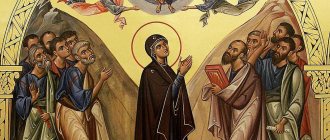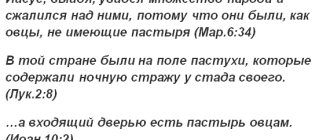God is one in essence, but three in persons: Father, Son and Holy Spirit, the Trinity is consubstantial and indivisible.
The word “Trinity” itself, of non-biblical origin, was introduced into the Christian lexicon in the second half of the 2nd century by St. Theophilus of Antioch. The doctrine of the Holy Trinity is given in Christian Revelation.
The dogma of the Holy Trinity is incomprehensible, it is a mysterious dogma, incomprehensible at the level of reason. For the human mind, the doctrine of the Holy Trinity is contradictory, because it is a mystery that cannot be expressed rationally.
It is no coincidence that Fr. Pavel Florensky called the dogma of the Holy Trinity “a cross for human thought.” In order to accept the dogma of the Most Holy Trinity, the sinful human mind must reject its claims to the ability to know everything and rationally explain, that is, in order to understand the mystery of the Most Holy Trinity, it is necessary to reject its understanding.
The mystery of the Most Holy Trinity is comprehended, and only partially, in the experience of spiritual life. This comprehension is always associated with ascetic feat. V.N. Lossky says: “The apophatic ascent is an ascent to Golgotha, therefore no speculative philosophy could ever rise to the mystery of the Most Holy Trinity.”
Belief in the Trinity distinguishes Christianity from all other monotheistic religions: Judaism, Islam. The doctrine of the Trinity is the basis of all Christian faith and moral teaching, for example, the doctrine of God the Savior, God the Sanctifier, etc. V.N. Lossky said that the doctrine of the Trinity is “not only the basis, but also the highest goal of theology, for ... to know the mystery of the Most Holy Trinity in its fullness means to enter into Divine life, into the very life of the Most Holy Trinity.”
The doctrine of the Triune God comes down to three points:
- God is trinity and trinity consists in the fact that in God there are Three Persons (hypostases): Father, Son, Holy Spirit.
- Each Person of the Holy Trinity is God, but They are not three Gods, but are one Divine being.
- All three Persons differ in personal, or hypostatic properties.
How many Gods do Christians believe in?
In short: the Christian Church believes in one God, who is one in essence, but trinitarian in Persons.
Now a little more detail.
From the books of Holy Scripture (Old and New Testaments) the Church firmly knows that God is one. But from the same books and patristic interpretations on them it follows that He is alone, not in the sense in which we can say this about any person. God is one, but not alone. It is triune: there are three Divine Hypostases, or Persons.
Each of the Persons is God in all His fullness, all God, entirely. Each Hypostasis of the Trinity has all the Divine power, all the fullness of power, all the glory, etc. Any action of the Holy Trinity is performed by all three Persons, so that Orthodox theologians talk about the single action and single will of the three Hypostases. Nevertheless, these are precisely three independent Persons, and not three, say, “masks” that the Divinity alternately puts on and in which He reveals himself.
The trinity of God is spoken of in the Creed, the key confessional formula approved at the first two Ecumenical Councils in 325 and 381 A.D. When we pronounce the Creed, we confess faith “in the One God the Father Almighty... and in the One Lord Jesus Christ , the Son of God... and in the Holy Spirit, the life-giving Lord...".
How not to think about the trinity of God?
Anyone who wants to talk about the nature of the Divine must understand that he is stepping on ground on which to walk without reverence means endangering his soul. One should not think that the dogma of the Holy Trinity is so simple to explain.
Trinity theology underlies the Church's teaching about God and has been developed over several centuries. Theologians and learned men of many generations have racked their brains to express in words the Revelation of the Unity of the Divine in Trinity and His Trinity in Unity. This was not easy, gave rise to several heretical teachings and was settled by Ecumenical Councils .
We must choose our words carefully and reverently when attempting to explain the doctrine of the Holy Trinity to others.
God is one, but threefold - how can an ordinary believer, and not a theologian, understand this?
To help believers come closer to understanding the mystery of the Holy Trinity, the Church Fathers offered analogies from our earthly world. For example, Gregory the Theologian gave examples with the sun, its light and heat, as well as with a water source, stream and river; Basil the Great - with a rainbow divided into stripes of different colors; Blessed Augustine - with the human mind, thought and word; Dionysius the Areopagite - with three candles giving a single light. But all such “illustrations” borrowed from the earthly world must be treated as very imperfect metaphors, understanding that they inaccurately describe the relationship of the three Divine Persons and do not allow one to truly penetrate into the mystery of the Trinity being.
Why is the doctrine of the Trinity so important to Christians?
To put it quite simply, because it serves as the basis of the Christian view of the world, of what is the driving force and meaning of our lives.
From the Gospel we know: God is love (1 John 4:8). Love is not just one of the characteristics of God, not just His relationship to created beings, but a key principle of Divine existence. God is love always, He was love before He created the world, and He will remain love after the earth and all the works on it are burned up (2 Pet 3:10). The existence of the world is not a necessary condition for God to be love. He is love already in Himself.
But in love there are always at least two parties who love each other. And, if God really is love, He cannot be a Person closed in Himself, as, for example, the famous philosopher and scientist Gottfried Leibniz believed. He must be at least a Two.
We are familiar and understand the situation when two people love each other. But the Holy Scripture says something much less understandable about God: He is the Trinity and He is love.
Perhaps it will be a little easier for us to understand this if we look at a family in which there is a father, mother and child. Mother and father love each other, but do not completely isolate themselves on each other, but generously share this love with the third child (or with children, if there are several of them). It happens that a married couple does not have children, but even then their love can be poured out on someone else, be it an adopted child, elderly parents, or even some stranger in need of help (this is how they lived, giving themselves to those in need, for example, the childless Grand Duke Sergei Alexandrovich Romanov and his wife Elizaveta Feodorovna).
Of course, relationships between people cannot be directly projected onto Divine reality. And yet, the example of the family shows that true love cannot have a “third wheel.”
“Trinity implies equality of rights for more than two, it makes love perfect,” emphasizes Archpriest Maxim Kozlov, professor at the Moscow Theological Academy.
“Perfect love is the paradoxical unity of two facts: on the one hand, the existence of several “I”s that love each other while remaining separate, and, on the other hand, the highest degree of unity between Them,” wrote the famous Romanian theologian Archpriest Dumitru Staniloe in the 20th century . - There can be no other justification for love in the world, no other purpose for the existence of the world, other than the existence of perfect eternal love. Love in the world presupposes as its source and goal eternal perfect love between several Divine Persons.”
Of course, we will never be able to exhaustively explain why God is threefold: the human mind cannot comprehend the mystery of Divine existence. Theologians are just trying to describe the relationship of the three Hypostases with the words that are at their disposal, and to understand what follows from this for the Church and for every Christian.
What does the New Testament say about the Trinity?
In the books of the New Testament, the three Persons of God are directly spoken of in only two places. Firstly, in the Gospel of Matthew. The risen Christ commands the apostles: Go and teach all nations, baptizing them in the name of the Father and the Son and the Holy Spirit (Matthew 28:19). Theologians traditionally draw attention to the fact that here we are talking about one name, but three Persons are named.
And, secondly, in the First Epistle of the Holy Apostle John the Theologian. There is a verse in this book: For three bear witness in heaven: the Father, the Word and the Holy Spirit; and these three are one (1 John 5:7). True, there is a difficulty with these lines - they may not have been in the original text of the Message. In any case, they are not in any of the oldest surviving manuscripts of the New Testament in Greek - neither in the Codex Sinaiticus, nor in the Vaticanus (both dating from the 4th century), nor in the Alexandrian (5th century). The ancient Church Fathers, with a few exceptions, did not quote this verse. Therefore, today many Western editions of the New Testament are published without these words.
There are, however, quite weighty arguments in favor of the authenticity of this verse, notes Archpriest Oleg Davydenkov, Doctor of Theology, Professor at the Orthodox St. Tikhon Humanitarian University. It has been established, in particular, that the controversial lines were contained in the so-called Itale - an Old Latin translation of the Bible, made in the 2nd-3rd centuries from the Greek original. This verse is also contained in many Syrian and Armenian ancient manuscripts. In the middle of the 4th century, Saint Athanasius the Great referred to it, and a little later - Saint Gregory the Theologian.
It is possible that these lines disappeared from Greek manuscripts through the efforts of the Arians, suggests Father Oleg. Arians were the followers of the Alexandrian heretic Arius, who considered Jesus Christ not to be God, but only the highest of God’s creations. For several decades of the 4th century, the Arians played a dominant role in that part of the Church that was located in the eastern Roman Empire, including the territories of Greece and present-day Turkey. In the West, the Arian heresy never had serious support. Perhaps this is why in the old Latin translation of the Bible and in those translations that were carried out from Latin, the lines about the “three heavenly Witnesses” were preserved.
Analogies
- Three states of water.
Water has three states: solid (ice), liquid and gaseous (steam). Their properties are different, but, nevertheless, they are the same substance. - Three essences of man.
Man was created in the image and likeness of God (Gen. 1:26), that is, triune, having spirit, soul and body (1 Thess. 5:23). Also - will, reason, emotions. - A person, in relation to relatives
- every mature man who has children is also both father and son. The roles of son, father, and husband are different, and relationships with others depend on the role, although they are performed (in our example) by one person. - Circle in a square.
Problem with answer: In the beginning there was a circle, and the circle was square.
What came first: the circle or the square? They were both in the beginning (i.e., co-beginning). For comparison: John 1:1 In the beginning was the Word, and the Word was with God, and the Word was God.
(The concept of the Word in the Gospel of John is identified with Jesus Christ; it is he who is designated by the term “Word”).
Is this all there is about the Trinity in the New Testament?
No, not all of them. We talked only about direct New Testament indications of the trinity of God. And there are many indirect ones, but no less important.
For example, all the Gospels speak of the Baptism of the Lord Jesus Christ in the Jordan River, during which a unique event occurred - the appearance of the entire Holy Trinity. The Holy Spirit descended on Jesus Christ in the form of a white dove, and the voice of God the Father thundered from heaven: This is My beloved Son, in whom I am well pleased (Matthew 3:17). In honor of this event, the Church established a special holiday, which it called the Epiphany (or Baptism of the Lord), and in its troparion - a special hymn explaining the significance of the celebrated event - proclaimed: “When You, Lord, were baptized in the Jordan, the worship of the Most Holy Trinity: for the voice of the Father testified of You, calling You the beloved Son, and the Spirit in the form of a dove confirmed the truth of this word” (Russian translation of the Church Slavonic text).
True, when describing this event, the evangelists do not call the Holy Spirit God, but His Divine dignity is repeatedly emphasized in other New Testament books.
During his farewell conversation with his disciples, the Lord Jesus Christ calls the Holy Spirit another Comforter, who will abide with the apostles forever and teach... everything (John 14:16, 25). With the same word παράκλητος (in this case translated as “Comforter”) Christ called Himself a little earlier.
In the book of the Acts of the Holy Apostles, Peter denounces Ananias, who tried to deceive his fellow Christians, and says: Why did you allow Satan to put into your heart the idea of lying to the Holy Spirit and hiding from the price of the land?.. You lied not to men, but to God (Acts 5:3, 4).
For the Apostle Paul, the expressions “temple of God” and “temple of the Spirit of God” are synonymous: Do you not know that you are the temple of God, and the Spirit of God lives in you? (1 Cor 3:16).
There are many other places in the Holy Scriptures that testify to the Holy Spirit as an independent Person of the Most Holy Trinity. And even more so, in the New Testament there is no shortage of evidence of the Divinity of Jesus Christ.
Sometimes you hear that all such testimonies are collected in one place - the Gospel of John: it is here that the Savior says I and the Father are one (John 10:30), whoever has seen Me has seen the Father (John 14:9), here He accepts the confession of the Apostle Thomas My Lord and my God! (John 20:28)…
Even if this Gospel were the only basis for our faith in the Divine dignity of the Lord Jesus, faith itself would not be shaken by this. But in fact such evidence is scattered throughout the New Testament.
Let us at least remember the parable of the Last Judgment, in which Christ Himself, calling Himself the Son of Man, sits on the throne of glory, turns out to be the Judge of all nations and the Commander of the angels (Matthew 25:31-46). Let us recall a fragment of the Gospel of Luke, when the Savior heals ten lepers and, surprised that only one of them returned to thank Him, says: Were not ten cleansed? Where is nine? How did they not return to give glory to God except this foreigner? (Luke 17:17–18). Let us finally remember the Apostle Paul, who writes to the Galatians that the Gospel he preaches is not human, for he received it and learned it not from man, but through the revelation of Jesus Christ (Gal. 1:11-12), to the Colossians - that In Christ dwells all the fullness of the Godhead bodily (Col. 2:9–10), and to the Romans that Christ is “God over all, blessed forever” (Rom. 9:5).
Interesting Facts
- The word "Trinity" is not a name for God, but a theological term indicating the essence of the Godhead.
- The idea of trinity can be traced in many pagan religions, which can serve as proof of the truth of the Christian doctrine of the Trinity: all nations descend from Noah, who knew the True God (Gen. 6:9). His descendants could preserve the memory of the True God, although in a greatly distorted form.
- When describing the unity of God in the Bible, for example in the verse “The Lord our God, the Lord is one”
(Deut. 6:4), the Hebrew word echod (one) is used, which does not mean an absolute homogeneous unity, but often a complex unity. For example: a husband will cleave to his wife and they will become one (echod) flesh (Gen. 2:24). - The founder of Islam, Muhammad, did not know the Christian doctrine of the Trinity, but he heard about it, which was reflected in the Koran. The Quranic Trinity consists of Allah, Jesus and the Virgin Mary (instead of the Holy Spirit) (Sura 5:116).









